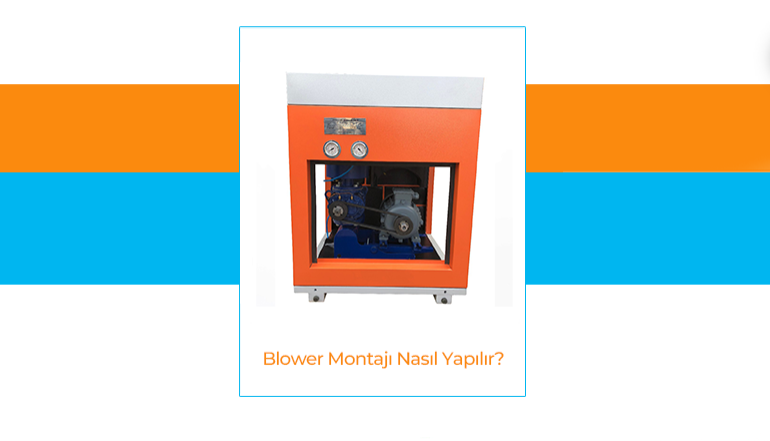- sisdoz@sisdoz.com.tr
- TR
Blog
- Home
- Sisdoz Blog
- How to Install a Blower?

Blower installation is the process of physically placing a blower in its location, making the piping and electrical connections, and activating the system. Proper blower installation is critical to industrial efficiency. In this guide, you'll learn the installation steps step by step and discover what to consider for an efficient and safe system.
Introduction: Why Is Blower Installation Important?
Blower systems, used in many areas from industrial facilities and wastewater treatment systems to the food and chemical industries, play a vital role in processes such as airflow management, vacuum generation, and gas transfer. However, for these systems to function properly, they must be installed flawlessly. Improper installation can lead to poor performance, energy waste, and shortened equipment life.
1. Preparation: Start with Proper Planning
Proper planning is the foundation of every successful installation. In the first step, the type and capacity of the blower to be used should be determined, and the physical conditions of the area, airflow requirements, and installation site characteristics should be thoroughly analyzed.
Is there adequate ventilation at the installation site?
Is there a suitable infrastructure for vibration and sound insulation?
Are the electrical connections and control panel sufficient?
The answers to these questions will ensure that the next steps proceed smoothly.
2. Choosing the Proper Ground: Solid Foundation, Healthy Operation
Blowers are generally high-speed machines. Therefore, the ground must be solid enough to absorb vibration. Placing them on a concrete surface is recommended. They should also be supported with vibration pads or spring feet.
The levelness and stability of the ground during blower installation are prerequisites for the efficient operation of the system.
3. Positioning the Blower: Correct Location, Low Risk
When placing the blower, leave at least 50 cm of space around it to provide adequate space for maintenance and air circulation. The suction and discharge directions should be positioned appropriately for the application. A weather-resistant enclosure is recommended, especially if installed outdoors.
4. Piping and Connections: Ensure Airflow is Not Obstructed
The piping system directly affects blower performance. Wide-angle elbows should be used in curved connections, and the pipe diameter should be appropriate for the blower outlet. Additionally:
Pipes should be secured with flexible connections to prevent vibration transmission.
Gaskets and flange connections should be carefully checked to ensure there are no leaks in the vacuum line.
5. Electrical Connection: Safe and Compliant with Standards
A switch and fuse system appropriate to the blower system's motor power should be installed. When making electrical connections:
Grounding should not be neglected,
Power supply should be provided in accordance with the voltage and frequency values on the blower motor nameplate,
Protection elements such as thermal relays and contactors should be included in the system.
6. Control Panel Integration: Don't Forget Automation
Many blowers are operated by connecting them to automatic control systems. Systems integrated with PLCs, inverters, or timers:
Energy savings are achieved,
Operation is simplified,
Conditions such as emergency stops or overheating can be automatically detected.
To avoid confusion during wiring, each cable should be marked and cable ducts should be used.
7. Cooling and Ventilation: Reduce Thermal Risks
Blowers generate heat during operation. Therefore, adequate ventilation must be provided in the area where the blower is located. Otherwise, motors will overheat, efficiency will decrease, and the system may fail. In closed spaces, fan-assisted air circulation or air conditioning systems may need to be installed.
8. Testing and Commissioning: Is Everything OK?
After installation is complete, the following checks should be made before starting the system:
Are all connections tight?
Have electrical tests been successfully completed?
Are there any air leaks in the pipeline?
Are vibration and noise levels normal?
The blower should then be gradually commissioned and tested under load. This allows for early detection of potential installation errors.
9. Periodic Maintenance Plan: The Secret to Long-Lasting Operation
After installation is complete, regular maintenance is crucial, not just for operating the blower. The following maintenance schedule can be implemented:
Weekly: Filter cleaning, vibration check
Monthly: Electrical connections, oil level check
Semi-Annual: Pipe connection leak test
Annual: General performance test and spare parts check
A maintenance plan ensures the trouble-free and efficient operation of your blower system for many years.
Result: Correct Installation, Correct Performance
Blower installation is a process that requires expertise. When all steps are followed carefully, your system will operate more efficiently and last longer. Proper installation is essential, especially for energy efficiency, ease of maintenance, and operator safety.
At Sisdoz, we support you throughout the entire blower system process, from installation and service to training and consulting. Our expert technical staff provides both on-site and remote support. You can trust us for the right blower, the right installation, and the right service.

